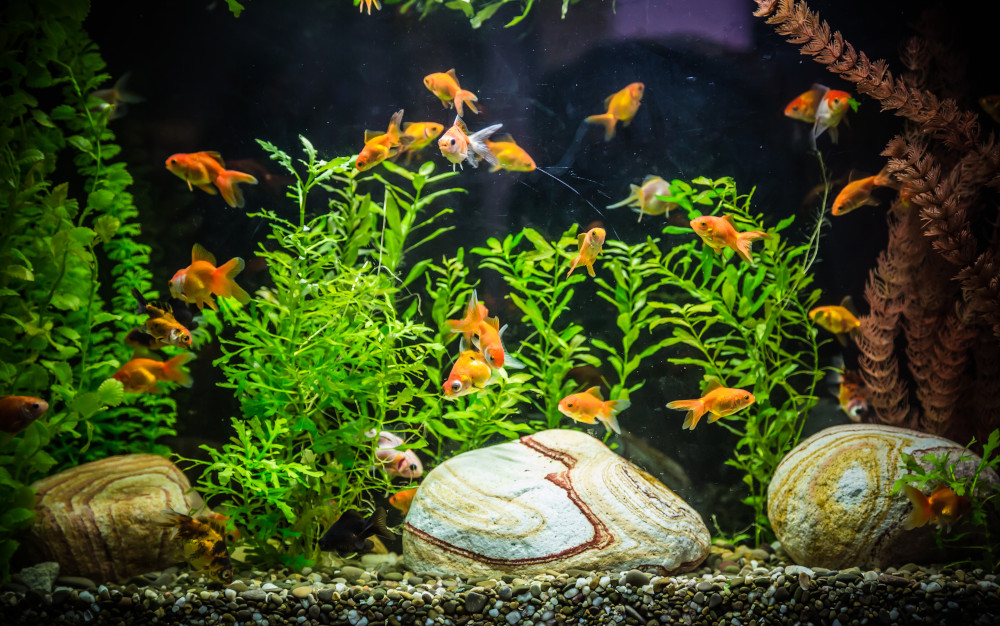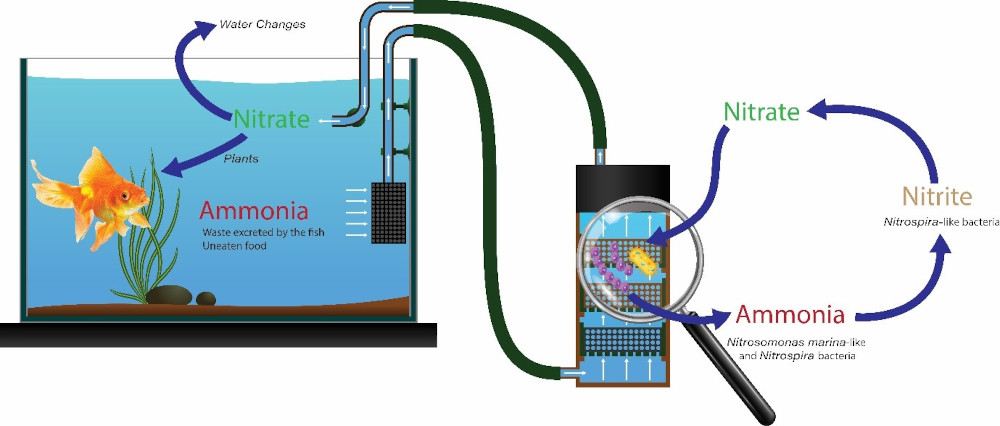
The key to a beautiful aquarium with healthy fish is effective filtration and maintaining water quality.
There are three types of filtration in aquariums:
- mechanical (using sponges to collect debris)
- chemical (to absorb specific toxins)
- biological (to break down fish waste)
Of the three types of filtration, biological is the most important.
Biological filtration
The information below refers to freshwater aquariums.
The number one cause of fish loss/death in aquariums (particularly new aquariums) is not having an effective biological filter (biofilter), leading to an accumulation of toxic waste products, particularly ammonia.
Fish excrete ammonia as the end-product of protein metabolism (similar to what we excrete in our urine). Fish however excrete this ammonia through their gills. Other waste products in an aquarium are fish faeces, uneaten food, and decaying plants, which are also broken down to ammonia. Ammonia is toxic to fish at 0.1ppm (that is 1 part in 10 million!!). Ammonia is more toxic in water of a higher temperature (tropical fish versus temperate fish) and also a higher pH.
A good quality biological filter is required to breakdown these toxic aquarium waste products to keep your fish healthy and happy. This process is referred to as the Nitrogen Cycle or Nitrification Cycle. It requires the establishment of beneficial bacterial colonies which convert the waste products into less harmful compounds.
There are two main stages in the Nitrogen Cycle (see picture below). In a new aquarium (or new filter) there are not enough beneficial bacteria to eliminate all toxins immediately, so for a period of four to six weeks, steps need to be taken to reduce risks to fish health and welfare and to prevent fish deaths.
The Nitrogen Cycle
There are two important stages in the Nitrogen Cycle.
First stage – Ammonia to Nitrite
- All the fish waste ends up as ammonia which is highly toxic to your fish.
- In a new aquarium, ammonia levels usually begin rising by the third day after adding fish.
- A group of bacteria convert the ammonia to nitrite which is slightly less toxic.
- As these bacteria numbers increase, the ammonia level drops and the nitrite level increases.
- Nitrite levels usually begin rising during the second week after adding fish.
Second stage – Nitrite to Nitrate
- A second group of bacteria convert the nitrite to nitrate which is much less toxic.
- As these bacteria numbers increase, the nitrite level drops and the nitrate level increases.
- When nitrates are being produced and ammonia and nitrite levels are zero, your tank is fully cycled and your biological filter is fully functioning (usually takes 4 to 6 weeks).
- In low levels, nitrates are not highly toxic to fish. Routine partial water changes of about 10% per week should keep nitrate levels within a safe range.

The bacteria involved in the Nitrogen Cycle are aerobic (requiring oxygen) and so aeration is critical to have a healthy biofilter as well as for your fish to breathe. These beneficial bacteria grow on any surface in the aquarium, and they are concentrated in the filter sponge/media which has a high surface area. By constantly flowing water through the filter, ammonia and nitrite are rapidly converted to nitrates, assisting in keeping tank water free of toxic levels of these compounds.
When starting a new aquarium, until the Nitrogen Cycle is established, test the water every two to three days for ammonia and nitrite for the first six weeks. Once your biofilter is established, testing every one to two weeks is sufficient to ensure your biological filtration is sufficient, you are maintaining it appropriately and your aquarium is not overstocked or overfed. In the first few weeks as the ammonia level increases followed by the nitrite increase, frequent water changes (every 2 to 3 days) will be needed to reduce the toxic levels until the bacteria numbers increase.
Initially, frequent partial water changes of 10 to 25% of the tank water are recommended combined with a gravel clean to remove waste and to help keep your fish healthy. Once the tank is established, this can be done weekly. A gravel siphon purchased from a pet store should be used. Gently shake the siphon briefly in the aquarium to start the flow of water into a bucket below. Use a dedicated (labelled) fish bucket which will not be used for other purposes to avoid any harmful chemical residues. The end of the siphon in the tank can be used to clean the gravel by vacuuming the substrate to remove fish faeces and any uneaten food. Fish can stay in the aquarium while siphoning to minimise stress, though care should be taken not to move too rapidly as this may stress the fish.
NEVER suck on the hose to start a siphon as this can cause human health issues.
After 10 to 25% of the water is drained, replace the water with tap water. It is worth having a second bucket that was filled the day before with tap water. This allows some of the chlorine to gas off and. also brings the water temperature up to room temperature. Before adding this new water, it is very important to add the appropriate quantity of an aquarium Water Conditioner (sometimes called water agers) to neutralise the chlorine and chloramine present in the tap water. Carefully read the label of the product that you are using.
Handy Tip – use the old aquarium water on your plants. It is a great fertilizer.
Once your biofilter is mature, weekly partial water changes of 10 to 25% are recommended combined with a gravel clean to remove waste and to help keep your fish healthy. The inside of aquariums can be cleaned of any algae build-up by wiping the insides gently with a clean, aquarium safe sponge or with a magnetic glass cleaner. Never use soap or detergents when cleaning an aquarium.
The filter should be rinsed lightly in a bucket of tank water when it starts to get clogged up or on a monthly basis (whichever occurs first). It is important to avoid over-cleaning the filter media as this will remove the beneficial bacteria. Without beneficial bacteria in the filter, ammonia from fish waste will not be broken down to less harmful nitrates, leading to fish death. Do not use tap water to clean the filter, as the chlorine (or chloramines) may also kill the beneficial bacteria.
Your filter is ultimately only as effective as the media it contains. There are many types of biological media available on the market and it is important to select media which has a high surface area for increased biological capacity.
Do not add large numbers of fish to your aquarium at any one time – gradual introduction will enable the filtration bacteria to slowly adapt.
If you need specific advice on how to safely cycle a tank, please consult an experienced aquarist (fish keeper) or fish veterinarian for further advice about how to safely cycle a tank.
Further information and videos are available at Aquarium Care 101 (Aquarium School / The Aquarium Vet).
Other water quality parameters that must be considered are pH and temperature. Different species of fish have specific requirements for pH and temperature. These are discussed in the articles below:
- How do I care for my goldfish?
- How do I care for my Siamese fighting fish?
- How do I care for my tropical fish?
Marine/saltwater aquariums
These are more difficult to establish and maintain, and some experience is needed. In marine/saltwater aquariums, biofilters take twice as long to mature compared to freshwater. If you wish to have a marine aquarium, please consult an experienced aquarist (fish carer) or fish veterinarian for further advice.
Reference
Francis-Floyd R, Watson C, Petty D, Pouder DB (2023). Ammonia in Aquatic Systems, University of Florida, IFAS Extension, FA16.

